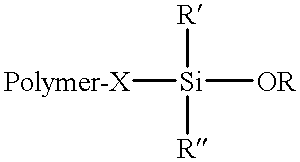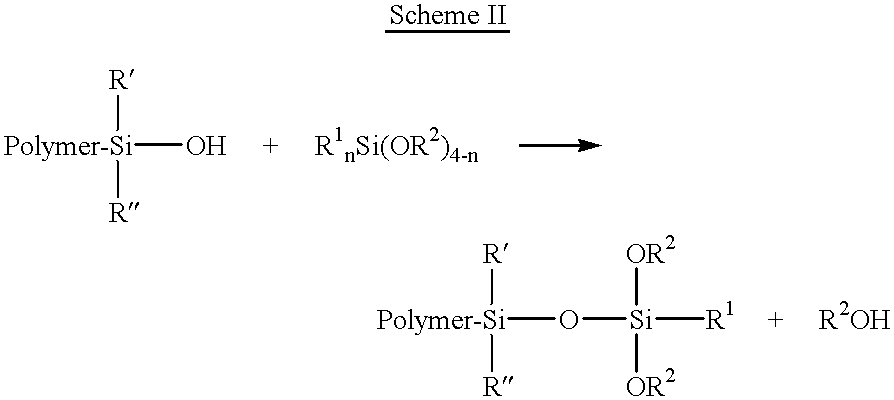Method to control increase in viscosity during aging of siloxane modified polymers
a technology of modified polymers and viscosity, which is applied in the direction of special tyres, transportation and packaging, tyre parts, etc., can solve the problems of increasing the viscosity and coupling rate of polymers, slowing substantially the hydrolysis reaction rate, and continuing the problem of increasing mooney viscosity and coupling. achieve the effect of controlling the increase in mooney viscosity
- Summary
- Abstract
- Description
- Claims
- Application Information
AI Technical Summary
Benefits of technology
Problems solved by technology
Method used
Image
Examples
Embodiment Construction
As noted hereinabove, the present invention is substantially directed toward a method for controlling, preferably stabilizing, and more preferably, eliminating the increase in Mooney viscosity, particularly during aging, of siloxane-functionalized polymers. The present invention succeeds in controlling and stabilizing Mooney viscosity by adding an effective amount of an alkyl alkoxysilane, preferably a low molecular weight alkyl trialkoxysilane, to the siloxane-terminated polymer prior to desolventization such that the alkyl alkoxysilane will react or couple with the hydrolyzable substituent such as a pendant --SiOR group of the siloxane-terminated polymers and form Si--O--Si bonds rather than having the hydrolyzable substituents of the siloxane-terminated polymers couple.
Siloxane-terminated polymers are well known in the art and have been prepared in U.S. Pat. No. 3,244,664 to Zelinski et al. and U.S. Pat. No. 4,185,042 to Verkouw, both of which are herein incorporated by reference...
PUM
| Property | Measurement | Unit |
|---|---|---|
| temperature | aaaaa | aaaaa |
| temperature | aaaaa | aaaaa |
| temperature | aaaaa | aaaaa |
Abstract
Description
Claims
Application Information
 Login to View More
Login to View More - R&D
- Intellectual Property
- Life Sciences
- Materials
- Tech Scout
- Unparalleled Data Quality
- Higher Quality Content
- 60% Fewer Hallucinations
Browse by: Latest US Patents, China's latest patents, Technical Efficacy Thesaurus, Application Domain, Technology Topic, Popular Technical Reports.
© 2025 PatSnap. All rights reserved.Legal|Privacy policy|Modern Slavery Act Transparency Statement|Sitemap|About US| Contact US: help@patsnap.com



